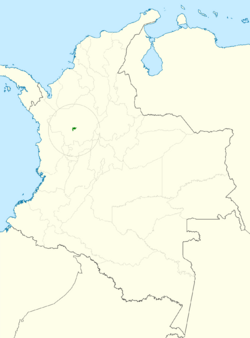Biology:Antioquia brushfinch
| Antioquia brushfinch | |
|---|---|

| |
| Scientific classification | |
| Domain: | Eukaryota |
| Kingdom: | Animalia |
| Phylum: | Chordata |
| Class: | Aves |
| Order: | Passeriformes |
| Family: | Passerellidae |
| Genus: | Atlapetes |
| Species: | A. blancae
|
| Binomial name | |
| Atlapetes blancae Donegan, 2007[2]
| |

| |
The Antioquia brushfinch (Atlapetes blancae) is a poorly known species of bird from the family Passerellidae. It was scientifically described in 2007 on basis of three museum specimens from Antioquia, Colombia, which were previously labelled as slaty brushfinches (Atlapetus schistaceus). The specific epithet blancae refers to the whitish underparts of the new species, while also commemorating the Colombian lepidopterologist Blanca Huertas, the wife of ornithologist Thomas M. Donegan (who described the species). All three museum skins were collected in the 20th century, but only one label has a date, which is given as 1971. Subsequent fieldwork in Antioquia has failed to find this species again. The species description has been approved by the South American Classification Committee. It has been recommended for a critically endangered status.[3]
Rediscovery
In January 2018, a Colombian resident of San Pedro de los Milagros noticed this bird on his way to Sunday mass. Since then, 4 subpopulations have been rediscovered, with at least 20 individuals between them. The bird had been previously overlooked despite living relatively close to the city of Medellín, which is home to 3.7 million people. Since then, the American Bird Conservancy has adopted a stance of optimism, stating that “Colombian researchers now know what kind of habitat to search and are continuing to find more birds. This brushfinch species is persisting in fairly small patches of low scrub close to people. Opportunities to protect remaining habitat patches as new reserves and to quickly restore working lands using silvipasture techniques [combining trees, forage, and livestock] hold great potential to benefit this species, but action must be taken quickly".[4]
References
- ↑ BirdLife International (2019). "Atlapetes blancae". IUCN Red List of Threatened Species 2019: e.T22735460A154909098. doi:10.2305/IUCN.UK.2019-3.RLTS.T22735460A154909098.en. https://www.iucnredlist.org/species/22735460/154909098. Retrieved 13 November 2021.
- ↑ Donegan, Thomas M. (2007). "A new species of brush finch (Emberizidae: Atlapetes) from the northern Central Andes of Colombia". Bulletin of the British Ornithologists' Club 127 (4): 255–268. https://www.biodiversitylibrary.org/part/76473.
- ↑ BirdLife International (2009) Species factsheet: Atlapetes blancae.
- ↑ "Species Unseen For 47 Years Rediscovered Near Colombian Town Named For Miracles". American Bird Conservancy. https://abcbirds.org/article/species-unseen-for-47-years-rediscovered-near-colombian-town-named-for-miracles/.
External links
- Conservationists concerned for new bird species
- Nueva especie de Gorrion Colombiano en Peligro de Extincion
- New Bird Species Recognised in Colombia, May Already be Extinct
- Recognize Atlapetes blancae as a species
Wikidata ☰ Q580894 entry
 |


